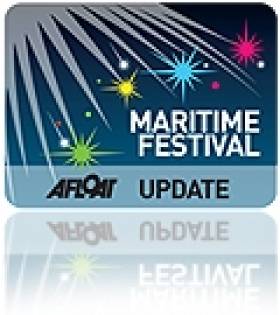Displaying items by tag: Docklands Summer Festival
#Docklands - World-class wakeboarding comes to Dublin's Grand Canal Dock this weekend (16-17 May) at the Waterways Ireland Docklands Summer Festival 2015.
Prepare to be wowed as the world's best wakeboarders showcase an array of grabs, spins and tricks, including European champion Carro Djupsjo from Sweden, British champion Meg Barker and Irish champion David O'Caoimh.
Organised by the Docklands Business Forum, the festival attracted over 60,000 visitors across the two days in 2014, with an even greater attendance expected this year.
The weekend will see an abundance of entertainment and competitions on both the water and the land. With everything from open air DJs, water sport come-try-it-sessions, a water golf challenge (with floating golfing green) to the tricky FM104 Corporate Raft Challenge, there will be plenty in store for a fantastic day.
The world-class wakeboarding demonstrations will feature a first ever for Ireland, with the public voting for the best performer through the unique DockFest15 voting app and big screen.
And there's lots on offer for the kids too including a 'rubber ducky' race, a children's arts centre at the Waterways Ireland Visitor Centre, a family funfair, champion street performers and international food markets.
For more visit www.docklandssummerfestival.com.
#MaritimeFestival – The Docklands Summer Festival, which this year is sponsored by Waterways Ireland, is a celebration of the Grand Canal Dock next weekend (17-18 May) and where entertainment and competitions are held on the water and on dry land.
The festival continues to entertain, from open air DJ's, Come Try it Sessions, Wake Boarding demonstrations to international food markets, the festival organisers promise an entertaining and fun filled weekend for all.
On the water activities include a wakeboarding competition, charity rubber ducky race, water sports, 'Come and Try It' sessions in kayaking and a canal barge gathering.
Additionally, there is plenty of activity for families to enjoy such as open air DJ's, an outdoor market, corporate golf challenge, street performers, balloon artists, face painters, fun fair attractions, & children's arts centre and theatre performances in the Waterways Ireland Visitor Centre.
Come and see world-class wakeboarding demonstrations on Saturday or watch as world-class wakeboarders, from up to seven countries to take part in the first International Wakeboarding Championship at Grand Canal Dock.
The wakeboard extravaganza will be formed by members of the International Waterski & Wakeboard Federation (IWWF). Irish teams will give wakeboarding demonstrations in the Grand Canal Dock on Saturday.
On the following Sunday, International riders will compete with the world's best water skiing skills and tricks over ramps while being towed behind a high performance motorboat.
East Wall Water Sports Centre will be on hand during the festival each day from 11am until 5pm to take you on the water to try out kayaking! Festival rates of €10 per adult and €5 per child. For more details of festival programme visit this link.
Entries Open For IUSRU Raft Race at Docklands Summer Fest
#InlandWaterways - The Irish Underwater Search and Recovery Unit (IUSRU) has announced details of its Raft Race as part of the Waterways Ireland Docklands Summer Festival.
Entry is €25 per person with four persons per raft for the day of wackiness on the water at Grand Canal Basin on 19 May.
And for those who can't build their own raft in time, prebuilt rafts can be supplied by the organisers.
More details of the event can be had from the IUSRU at 087 975 8656 or [email protected].
The complete programme of events for the Docklands Summer Festival will be posted on the official website shortly.
Summer Festival in the Heart of Dublin’s ‘Docklands’
The Docklands Summer Festival takes place this weekend in Dublin's 'Docklands' and it is to host the Waterways Ireland Inter-County Sailing Championship, writes Jehan Ashmore.
Other events taking place on the River Liffey and throughout the docklands range from a Dragon Boat display in the Grand Canal Dock (outer basin) and a Boat Show (inner basin) see map. In addition the Waterways Ireland Visitor Centre will be open, noting all these activities and venues are to take place between 10am-6pm on Saturday.
On the following Sunday the Waterways Ireland Inter-County Sailing Championship Races are scheduled between 10am-4pm in the Grand Canal Dock's outer basin. City Canal Cruises will operate each day as well as an International Food Market, held in the Grand Canal Square, opposite the Grand Canal Theatre.
The pristinely kept M.V. Cill Airne, now a floating restaurant and bar will be open at her berth alongside North Wall Quay, close to the striking Samuel Beckett Bridge and The Convention Centre.
The historic veteran vessel built in Dublin at the Liffey Shipyard in the early 1960's was launched as a passenger tender to serve trans-Atlantic liners that called to Cobh. During her tender-duties she brought the rich and famous ashore to include Laurel & Hardy and US President Eisenhower.
The festival is sponsored by Waterways Ireland and the Docklands Business Forum. To see the full festival programme and a map of the docklands click HERE and www.ddda.ie
- Waterways Ireland
- Cobh
- DDDA
- Dublin Bay News
- Port of Dublin
- River Liffey
- Grand Canal Dock
- Docklands Summer Festival
- Dublin Docklands Development Authority
- Samuel Beckett Bridge
- The Convention Centre
- North Wall Quay
- City Canal Cruises
- Grand Canal Theatre
- M.V.Cill Airne
- Passenger Tender
- TransAtlantic Liners
- Laurel & Hardy
- President Eisenhower
- US President Eisenhower
- Dublin City
- Docklands Business Forum
- Dragon Boat Display
- Dragon's
- Dragon sailing boats
- Dragon craft
































































